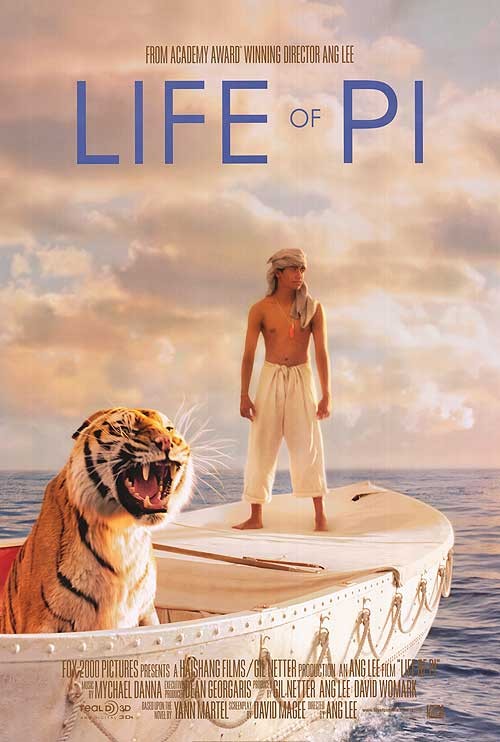The Journey Of A Lifetime
Director
Ang Lee
Starring
Suraj Sharma
Irrfan Khan
Rafe Spall
Adil Hussain
Tabu
In 2001 I was working in a bookshop and several of my colleagues were raving about this new novel about a boy in a boat with a tiger. As with most acclaimed contemporary fiction, I was largely uninterested. So little over a decade later they finally got round to releasing a cinematic adaptation and despite my apathy for the book, as a critic, I was intrigued but far from excited and compelled to see what I believed to be a story about a boy in a boat with a tiger. On the surface, that’s all the story is, a tale of survival and natural hardship. In actual fact, it’s a delightfully layered analysis of a young man’s evolving relationship with God, the nature of faith, an allegory for coping with suffering and a discovery of self… but there’s also a tiger.
The film opens with the introduction to Pi Patel [Khan], an Indian immigrant living in Canada and an unnamed writer [Spall], who has travelled to Pi’s home in search of a good story for his next novel. Pi slowly begins to relate his very long and tempestuous journey to North America, starting with his birth. His parents, Santosh [Hussain] and Gita [Tabu], run a zoo in Pondicherry and subsequently, Pi has always grown up surrounded by animals and the wonder of the natural world. Curiously enough, Pi was named after Piscine Molitor, a Parisian swimming pool but as the word piscine sounds like pissing, he is continually bullied in school. It’s only in his second year that he successfully reinvents himself as the mathematical symbol, Pi. As Pi grows up, he is heavily influenced by his mother’s religious beliefs and his father’s disdain for all religion. This produces a confusion in the boy that is quickly remedied when he adopts several major religions: Hinduism, Catholicism and Islamism. Of all the animals in the zoo, Pi takes an interest in the young Bengal tiger, which due to a clerical error, is named Richard Parker. When his father catches Pi trying to feed the tiger, he teaches him a scarring lesson: wild animals do not have souls. When you look into their eyes, you see your own emotions reflected back. When Pi [Sharma] turns 16, his father proposes moving their animals to Canada, to ensure his family’s survival. Reluctantly, Pi finds himself on the freighter travelling across one of the largest oceans to a new life. Partway across the pacific, a mighty storm ravages the ship and Pi manages to escape on a lifeboat with a small contingent of animals. All of whom die bar the tiger, Richard Parker.
Without a doubt, this is one of the most visually vibrant releases of the year. Upon first viewing the trailer, I thought the whole movie looked a little too pristine and polished, giving off that unnaturally smooth CGI look that populated another novel adaptation, The Lovely Bones. Thankfully, the entire thing is an absolute marvel to behold with some of the most credible computer generated characters ever to grace the screen. Additionally, I wrote off the pacing, assuming the majority of this story would be lengthy and arduous but in fact the shipwrecking incident takes place a considerable way in and much like Cast Away or The Old Man And The Sea, keeping the central focus on a sole character with little-to-nothing to cut away to has been executed with incredible precision and skill. This largely comes down to a combination of a very clever and compelling screenplay and spectacular performances. I say performances namely because, unlike many computer-generated characters, Richard Parker is an absolutely credible wonder. And I don’t simply mean visually; I can’t remember a single scene where I wasn’t gripped by a primal fear that at any moment the wild animal before me would simply snap and tear Pi to shreds. Then there’s Pi himself. From what I understand, Suraj Sharma had little to no previous acting experience but his quirky eccentricities, defiant human spirit and wracked faith are portrayed so exceptionally that it rivals the peak of several well-known actor’s prowess.
But this film is so much more than a story about a boy and a tiger in a boat, it’s a story about a child’s relationship with God and how it evolves through suffering to a man’s relationship with God. Curiously enough, most viewers appear to have had the same reaction to this release, one of an overwhelming emotional nature. For those without faith, they see a compelling tale of man’s domination over nature, his ability to overcome obstacles and conquer tragedy by crafting simple tools, keeping his mind active and taking responsibility for wildlife. For those with religious beliefs, this is a story of the power of faith, of the intervention of God and the trials and tribulations we must endure to really know ourselves and deepen our holdings with a higher power. Then you have a strange minority group, shared by two dramatically different individuals: those who are happy in their religion, without doubt or conflict (not so much the big twelve, more the really fundamentalist groups) and the strictly atheist, those who believe in no form of god, science or even people; and for those people, this is just a boring story about a boy and a tiger in a boat. However, the truly fascinating element isn’t what you see in the film but how you interpret the story. But I’ll expand on that in my highlighted scene below.
As far as negative aspects go, it’s quite difficult to really highlight any. I wasn’t blown away by this release but I certainly appreciated the intricacies and depth of the story-telling – having said that, this was all present in the book, so the film’s major keystone was pretty much already in place. The visuals, score, acting and directorial helming were all brilliantly achieved and will be deservedly heralded as such. At the end of the day, this movie’s success on a personal level is going to come down to preferences; specifically, do you like parables? If not, you’ll probably be bored or indifferent. If you do, then this will be a transportive and thoroughly captivating piece – it’s all a matter of opinion and perspective.
Release Date:
20th December 2012
The Scene To Look Out For:
**This whole paragraph is just a mess of spoilers, so don’t read if you have yet to see the film**
Once discovered and recuperating in hospital, Pi tells the story we have just witnessed to the freighter’s insurance agents. The only problem is they cannot and will not believe his fantastical tale, so demand a simpler one. Pi then recounts a different story, one which has several similarities but is laced with brutal reality, cannibalism and murder. The older Pi explains that both stories start with the sinking of the ship, the death of his family, a great deal of personal suffering and then he’s rescued, the question is which story the writer prefers. When the writer explains that the story with the tiger is the better story, Pi replies, “So it is with God.” And it’s this underlying statement about interpretation of traumatic events is what makes this story an emotional parable. Do you see this as a fanciful story about a boy sharing a boat with a wild animal or a boy fighting the guilt of his primal nature which comes out in order to help him survive the ordeal?
Notable Characters:
The supporting cast were pretty fantastic, no matter how brief or how long they were on-screen. However, to highlight anyone other than Sharma and the CGI tiger seems strangely antagonistic and pointless. The relationship is spectacular and its conclusion is utterly, utterly heart-breaking but for completely unexpected reasons. What else can I say?
Highlighted Quote:
“Doubt is useful, it keeps faith a living thing. After all, you cannot know the strength of your faith until it is tested”
In A Few Words:
“Life Of Pi is a beautiful visual tale layered with deep, rich analytical undertones. As such this is going to divide audiences between those who enjoy that kind of storytelling and those who despise it”
Total Score: 5/5
![The Red Right Hand Movie Reviews [Matthew Stogdon]](https://reviews.theredrighthand.co.uk/wp-content/uploads/2021/12/cropped-header1.png)




